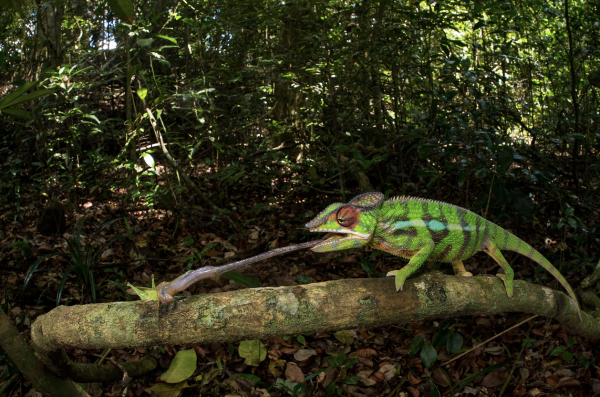With more than 6,000 species worldwide, lizards occur in every continent, except Antarctica. No wonder, they are the most abundant of all reptiles. Out of these, 60 species are present in California. Depending upon particular kind of species and habitat, lizards eat a wide variety of things. Actually, lizards come from the largest order of reptiles (which also includes snakes) called scaled reptiles. Normally, lizards walk on all four feet. Now let’s take a deep dive into what do lizards like to eat in the wild.
What Do Lizards Eat In The Wild
Even though lizards eat both animal and plant matter, they are mostly carnivorous. In fact, almost all of lizard species are carnivores, except for two percent. Lizards, like iguanids get their energy from eating plants only. When iguanids are in their prime, they live off stem, leaves, fruits and flowers.

Panther Chameleon, native to Madagascar/Photo © CHRISTIAN ZIEGLER. Image Source: National Geographic
By means of sit-and-wait strategy, these reptiles tend to launch a sudden attack on their prey, capturing them by stealth. No wonder, they are known as ambush predators, and for good reasons.
Some of the smaller lizard species tend to feed on insects whereas larger ones can prey easily on mammals. Common lizards consume small terrestrial invertebrates, including spiders, flies, snails and insects. At first, common lizard basks in the sun and then, feeds on small insects. Basking is essential for the survival of such reptiles in order to warm themselves and remain active in daylight.
The preferred diet for chameleons, for instance, mainly consist of termites, beetles and grasshoppers. Likewise, geckos also like to eat moths and crickets.
When chameleons spot any nearby insect, they do not move a muscle and remain immobile. However, they constantly move their eyes before the attack. As they creep toward the insect, they project their long sticky tongue and haul the grasshopper back into its mouth.
Few lizard species tend to prey largely on ants and termites, mainly because they can be found rather easily and in large numbers. In fact, some ant-eating lizards have specialized techniques for feeding ants. Besides, they like to feed on ants in large numbers which is why such lizards have larger stomachs.
In invertebrates, lizards mainly consume grasshoppers, ants, spiders, wasps, beetles and aphids.

Oriental Garden lizard eats robber fly/Photo © AntonO. Image Source: Wikimedia Commons
Some lizards have powerful jaws, strong enough to crack shells of snails. Alligator lizards and skunks are among one of these.
Depending upon the size of lizards, some larger ones also tend to scavenge for mammals, fish and birds. What’s more, they are also known to feast on the eggs of birds and reptiles.
Monitor lizard can gobble up its prey as a whole thanks to its larger size. Some species are known to prey on fledglings as they climb high up in the trees with much ease. Beaded lizards and gila monsters are among one of such species.
Some larger species of lizards are highly venomous. However, in order to kill their prey, these reptiles usually seek help from their powerful jaws.
In mammals, the most favorite diet of some larger species are rabbits, hares and rodents.
No wonder, Komodo dragons can easily hunt down large mammalian prey. They are known to even kill domestic water buffalo as well.
Marine iguana likes eating algae seaweeds and such other underwater plants.
Recently, scientists found a shift in the eating habits of lizards. Researchers noted that as the temperature rose by 2 degrees, lizards fed mainly on predatory insects (like beetles and spiders) as opposed to herbivorous insects (like crickets). From this study, scientists had a sneaking suspicion that lizards may require more nutritious diet in warmer climates.
Sources:
“Common Lizard“. Woodland Trust. Accessed 17 March, 2021
Todd, Brian, and UC Davis. “Pests in Gardens and Landscapes“. UCIPM. Accessed 17 March, 2021
“At 2c warmer, lizards eat less healthily: study“. Phy.org. Accessed 17 March, 2021
